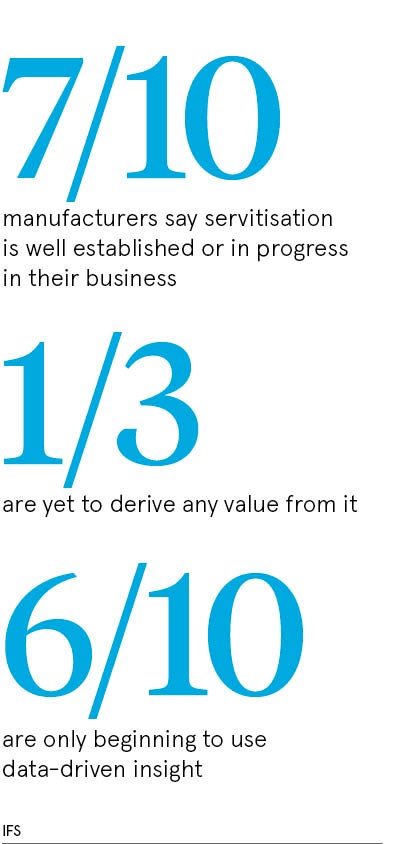Technology-driven disruption in the manufacturing sector has signalled an explosion in the servitisation business model as companies seek new revenue streams closer to the success and operations of their customers.
However, despite seven in ten manufacturers telling a recent IFS study that servitisation is well established or in progress in their business, one in three said they are yet to derive any value from it. Crucially, 58 per cent revealed they are only beginning to utilise data-driven insight, a core component of servitisation.
 Servitisation, which sees manufacturers innovate to compete through services rather than products alone, is endemic within manufacturing. While the 1990s saw steady growth in recognition that services can form the basis of competitive advantages, the emergence of Industry 4.0 in recent years has accelerated demand for the model.
Servitisation, which sees manufacturers innovate to compete through services rather than products alone, is endemic within manufacturing. While the 1990s saw steady growth in recognition that services can form the basis of competitive advantages, the emergence of Industry 4.0 in recent years has accelerated demand for the model.
Of particular interest are so-called advanced services, which focus on the delivery of outcomes rather than simply the provision of a product and the maintenance of its condition.
While more and more manufacturers are exploring and creating advanced services, led by success stories such as Xerox that moved from printing to document management and construction machinery giant Caterpillar, now lauded for its aftermarket logistics provision, a lack of openness to change has inhibited growth.
“These are the same cultural challenges that are inhibiting productivity improvements and are pervasive within society and traditional manufacturing industry,” says Professor Tim Baines, executive director of the Advanced Services Group, Aston University’s dedicated centre for servitisation research. “Bizarrely, the UK was a world leader in servitisation, but this has slowed.
“Developing this portfolio of services is challenging and takes time. There has been a masking effect in publicity about servitisation caused by hype around initiatives, such as Industry 4.0, but servitisation is here, it is embedded and is growing,”
The manufacturers that have struggled to derive value from servitisation have typically failed to understand that customers buy solutions because they view it as a way to move risk. Some companies also underestimate how well they know how their equipment is being used by customers and don’t build this into the revenue model, so they lose money.
“Because solutions are services and services are intangible, it is often difficult to communicate the value that is being created through their use, and customers can view them as a drain on finances,” says Mark Johnson, associate professor of operations management at Warwick Business School. “Also services make money over time and require different skills to deliver. Manufacturers that do well through this understand they often require different organisational units to deliver them well.”
Those that have made it a success share an understanding solutions need longevity. Both Xerox and Caterpillar, for example, have extensive remanufacturing operations to reduce costs, and they work well with partners to gain a deep understanding of their customers and how they can make them more productive. “At the heart of each of the solutions is a robust product supported by excellent services and an understanding of how to make money from it,” says Professor Johnson.
The internet of things and artificial intelligence are enabling servitisation to progress faster
The maturation of cloud-based technologies within Industry 4.0, including the internet of things and artificial intelligence, is now enabling servitisation to progress faster. Putting sensors on products creates digital data across a number of parameters, which manufacturers can use to understand more about how the product is used.
Armed with more advanced and integrated insights into their products, they can optimise performance and distribution, and create a range of services that utilise the data as well as improve the after-market experience.
These technological developments, along with changing views on ownership and resource use, enable manufacturers to see how customers are using their products and then add innovative services to help optimise that use, according to Duncan Johnston, UK manufacturing industry leader at Deloitte. “More companies will adopt it,” he says. “Processes that are currently bespoke will become standardised and many organisations will move to different business models.”
To achieve that move to a servitisation model, however, manufacturers need to reassess their culture and organisational structure. Evolving from a culture that prizes engineering excellence to one that places customer service at the heart of revenue generation requires a major shift in mindset. But knowing what is valuable to the customer will be the golden differentiator between manufacturers in Industry 4.0.





